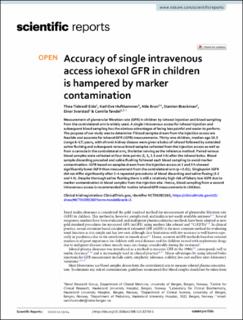Accuracy of single intravenous access iohexol GFR in children is hampered by marker contamination
Eide, Thea Tislevoll; Hufthammer, Karl Ove; Brun, Atle; Brackman, Damien; Svarstad, Einar; Tøndel, Camilla
Journal article, Peer reviewed
Published version

Åpne
Permanent lenke
https://hdl.handle.net/11250/2833704Utgivelsesdato
2021Metadata
Vis full innførselSamlinger
- Department of Clinical Medicine [2066]
- Registrations from Cristin [9791]
Sammendrag
Measurement of glomerular filtration rate (GFR) in children by iohexol injection and blood sampling from the contralateral arm is widely used. A single intravenous access for iohexol injection and subsequent blood sampling has the obvious advantages of being less painful and easier to perform. The purpose of our study was to determine if blood samples drawn from the injection access are feasible and accurate for iohexol GFR (iGFR) measurements. Thirty-one children, median age 10.5 (range 6–17) years, with chronic kidney disease were given a bolus of iohexol followed by extended saline flushing and subsequent venous blood samples collected from the injection access as well as from a cannula in the contralateral arm, the latter serving as the reference method. Paired venous blood samples were collected at four time points (2, 3, 3.5 and 4 h) after the iohexol bolus. Blood sample discarding preceded and saline flushing followed each blood sampling to avoid marker contamination. iGFR based on samples drawn from the injection access at 2 and 3 h showed significantly lower iGFR than measurement from the contralateral arm (p < 0.01). Singlepoint iGFR did not differ significantly after 3–4 repeated procedures of blood discarding and saline flusing (3.5 and 4 h). Despite thorough saline flushing there is still a relatively high risk of falsely low iGFR due to marker contamination in blood samples from the injection site. Hence, blood sampling from a second intravenous access is recommended for routine iohexol GFR measurements in children.
